An Overview of the Criminal Justice System in Australia
VerifiedAdded on 2020/03/04
|6
|1332
|61
Essay
AI Summary
This essay provides an overview of the Criminal Justice System in Australia, examining its structure and the roles of various participants. It highlights the significance of the federal system and its application across states and territories. The essay details the responsibilities of judges, juries, defense, prosecution, clerks, police, witnesses, and advocates within the court system. It emphasizes the importance of each role, from the judge's interpretation of the law to the jury's evaluation of evidence. The essay also discusses the roles of the complainant, the accused, and the prosecution, along with the functions of clerks, police officers, witnesses, and advocates in the legal process. References from various sources support the analysis of the criminal justice system in Australia.
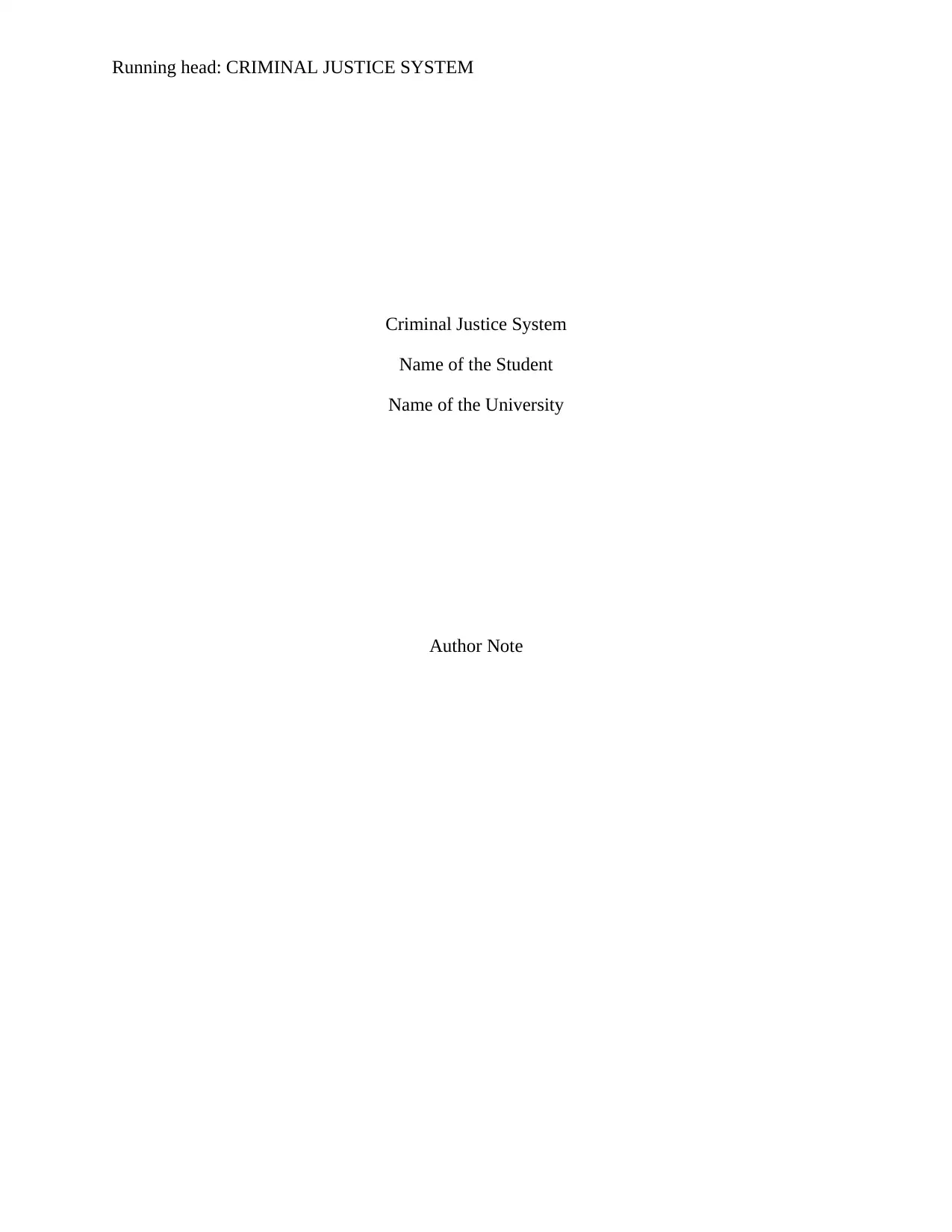
Running head: CRIMINAL JUSTICE SYSTEM
Criminal Justice System
Name of the Student
Name of the University
Author Note
Criminal Justice System
Name of the Student
Name of the University
Author Note
Paraphrase This Document
Need a fresh take? Get an instant paraphrase of this document with our AI Paraphraser
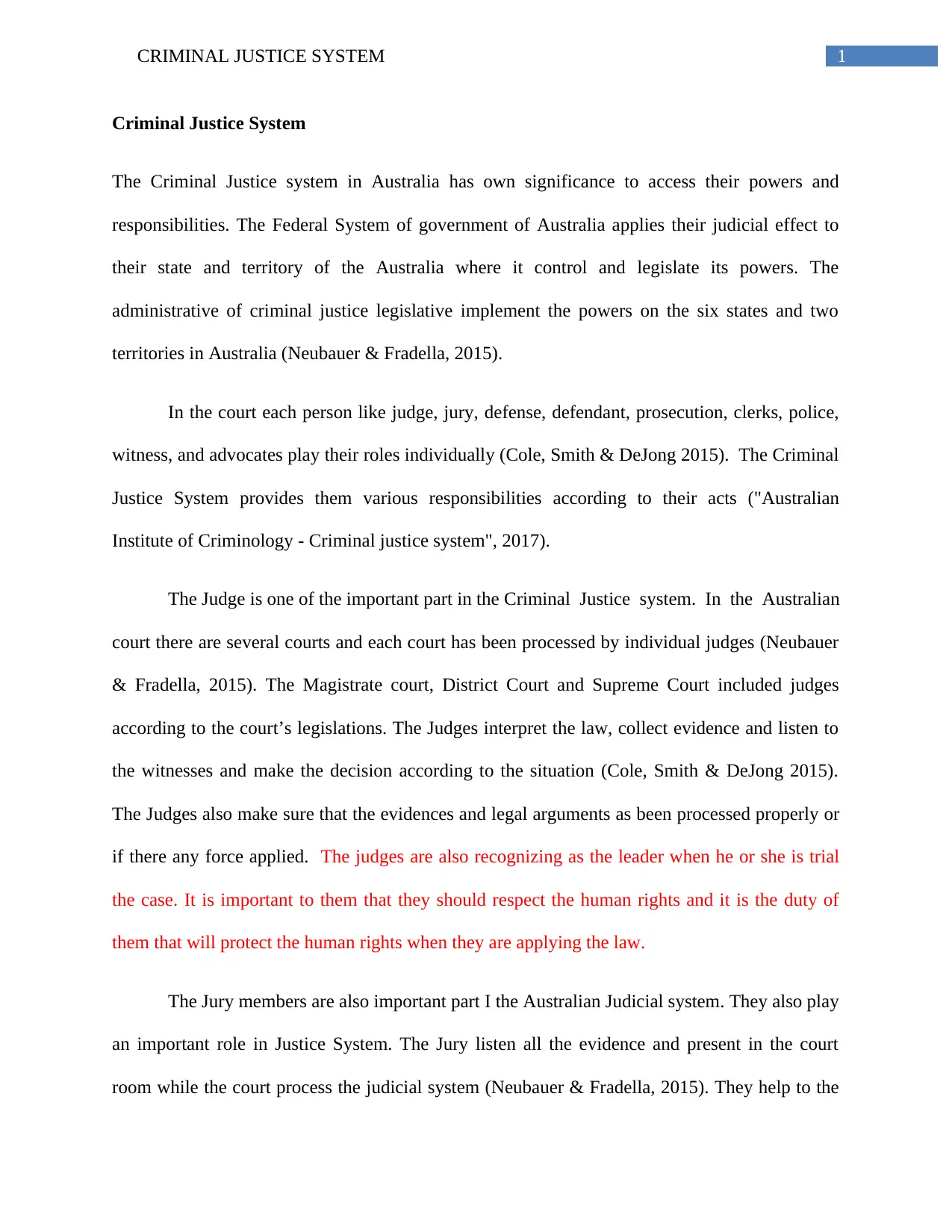
1CRIMINAL JUSTICE SYSTEM
Criminal Justice System
The Criminal Justice system in Australia has own significance to access their powers and
responsibilities. The Federal System of government of Australia applies their judicial effect to
their state and territory of the Australia where it control and legislate its powers. The
administrative of criminal justice legislative implement the powers on the six states and two
territories in Australia (Neubauer & Fradella, 2015).
In the court each person like judge, jury, defense, defendant, prosecution, clerks, police,
witness, and advocates play their roles individually (Cole, Smith & DeJong 2015). The Criminal
Justice System provides them various responsibilities according to their acts ("Australian
Institute of Criminology - Criminal justice system", 2017).
The Judge is one of the important part in the Criminal Justice system. In the Australian
court there are several courts and each court has been processed by individual judges (Neubauer
& Fradella, 2015). The Magistrate court, District Court and Supreme Court included judges
according to the court’s legislations. The Judges interpret the law, collect evidence and listen to
the witnesses and make the decision according to the situation (Cole, Smith & DeJong 2015).
The Judges also make sure that the evidences and legal arguments as been processed properly or
if there any force applied. The judges are also recognizing as the leader when he or she is trial
the case. It is important to them that they should respect the human rights and it is the duty of
them that will protect the human rights when they are applying the law.
The Jury members are also important part I the Australian Judicial system. They also play
an important role in Justice System. The Jury listen all the evidence and present in the court
room while the court process the judicial system (Neubauer & Fradella, 2015). They help to the
Criminal Justice System
The Criminal Justice system in Australia has own significance to access their powers and
responsibilities. The Federal System of government of Australia applies their judicial effect to
their state and territory of the Australia where it control and legislate its powers. The
administrative of criminal justice legislative implement the powers on the six states and two
territories in Australia (Neubauer & Fradella, 2015).
In the court each person like judge, jury, defense, defendant, prosecution, clerks, police,
witness, and advocates play their roles individually (Cole, Smith & DeJong 2015). The Criminal
Justice System provides them various responsibilities according to their acts ("Australian
Institute of Criminology - Criminal justice system", 2017).
The Judge is one of the important part in the Criminal Justice system. In the Australian
court there are several courts and each court has been processed by individual judges (Neubauer
& Fradella, 2015). The Magistrate court, District Court and Supreme Court included judges
according to the court’s legislations. The Judges interpret the law, collect evidence and listen to
the witnesses and make the decision according to the situation (Cole, Smith & DeJong 2015).
The Judges also make sure that the evidences and legal arguments as been processed properly or
if there any force applied. The judges are also recognizing as the leader when he or she is trial
the case. It is important to them that they should respect the human rights and it is the duty of
them that will protect the human rights when they are applying the law.
The Jury members are also important part I the Australian Judicial system. They also play
an important role in Justice System. The Jury listen all the evidence and present in the court
room while the court process the judicial system (Neubauer & Fradella, 2015). They help to the
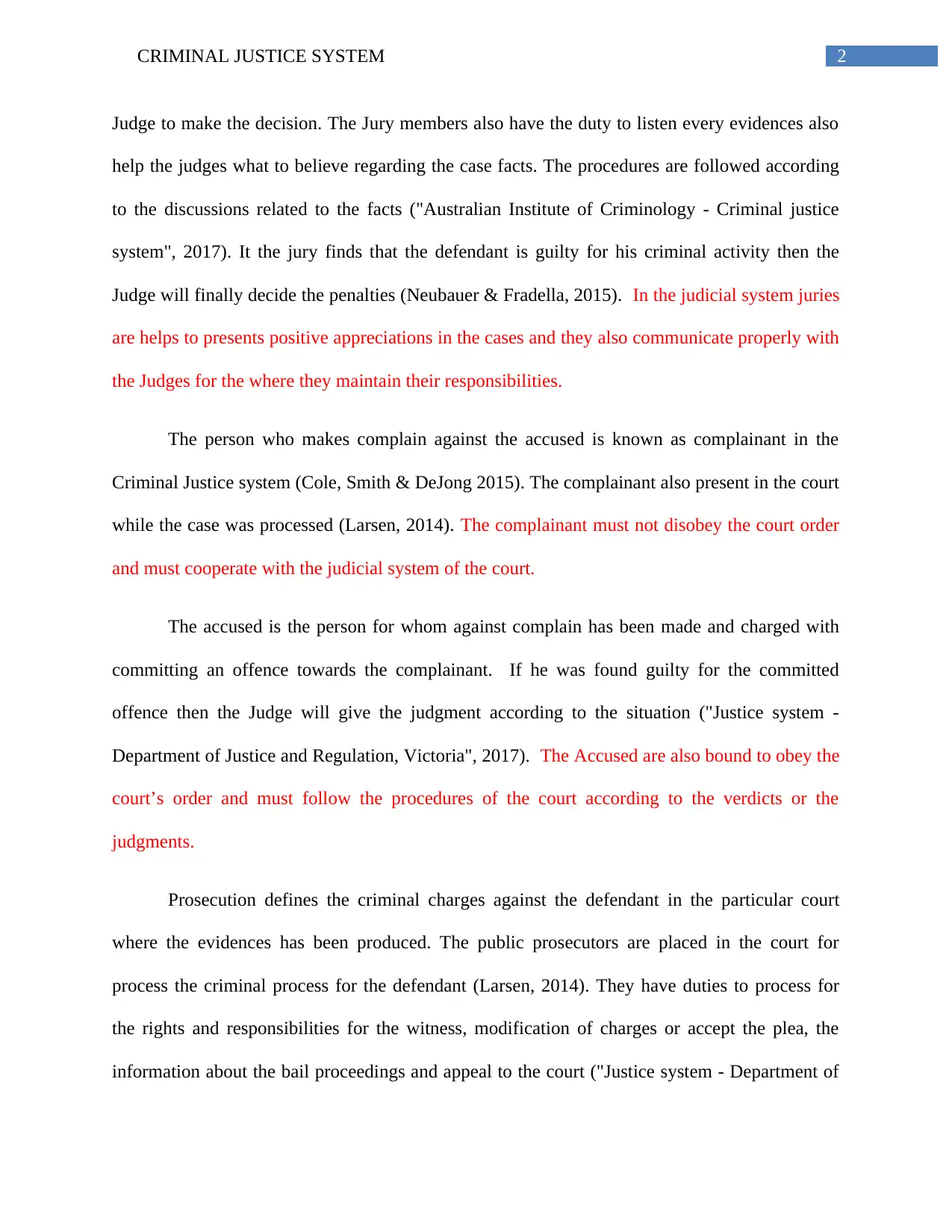
2CRIMINAL JUSTICE SYSTEM
Judge to make the decision. The Jury members also have the duty to listen every evidences also
help the judges what to believe regarding the case facts. The procedures are followed according
to the discussions related to the facts ("Australian Institute of Criminology - Criminal justice
system", 2017). It the jury finds that the defendant is guilty for his criminal activity then the
Judge will finally decide the penalties (Neubauer & Fradella, 2015). In the judicial system juries
are helps to presents positive appreciations in the cases and they also communicate properly with
the Judges for the where they maintain their responsibilities.
The person who makes complain against the accused is known as complainant in the
Criminal Justice system (Cole, Smith & DeJong 2015). The complainant also present in the court
while the case was processed (Larsen, 2014). The complainant must not disobey the court order
and must cooperate with the judicial system of the court.
The accused is the person for whom against complain has been made and charged with
committing an offence towards the complainant. If he was found guilty for the committed
offence then the Judge will give the judgment according to the situation ("Justice system -
Department of Justice and Regulation, Victoria", 2017). The Accused are also bound to obey the
court’s order and must follow the procedures of the court according to the verdicts or the
judgments.
Prosecution defines the criminal charges against the defendant in the particular court
where the evidences has been produced. The public prosecutors are placed in the court for
process the criminal process for the defendant (Larsen, 2014). They have duties to process for
the rights and responsibilities for the witness, modification of charges or accept the plea, the
information about the bail proceedings and appeal to the court ("Justice system - Department of
Judge to make the decision. The Jury members also have the duty to listen every evidences also
help the judges what to believe regarding the case facts. The procedures are followed according
to the discussions related to the facts ("Australian Institute of Criminology - Criminal justice
system", 2017). It the jury finds that the defendant is guilty for his criminal activity then the
Judge will finally decide the penalties (Neubauer & Fradella, 2015). In the judicial system juries
are helps to presents positive appreciations in the cases and they also communicate properly with
the Judges for the where they maintain their responsibilities.
The person who makes complain against the accused is known as complainant in the
Criminal Justice system (Cole, Smith & DeJong 2015). The complainant also present in the court
while the case was processed (Larsen, 2014). The complainant must not disobey the court order
and must cooperate with the judicial system of the court.
The accused is the person for whom against complain has been made and charged with
committing an offence towards the complainant. If he was found guilty for the committed
offence then the Judge will give the judgment according to the situation ("Justice system -
Department of Justice and Regulation, Victoria", 2017). The Accused are also bound to obey the
court’s order and must follow the procedures of the court according to the verdicts or the
judgments.
Prosecution defines the criminal charges against the defendant in the particular court
where the evidences has been produced. The public prosecutors are placed in the court for
process the criminal process for the defendant (Larsen, 2014). They have duties to process for
the rights and responsibilities for the witness, modification of charges or accept the plea, the
information about the bail proceedings and appeal to the court ("Justice system - Department of
⊘ This is a preview!⊘
Do you want full access?
Subscribe today to unlock all pages.

Trusted by 1+ million students worldwide
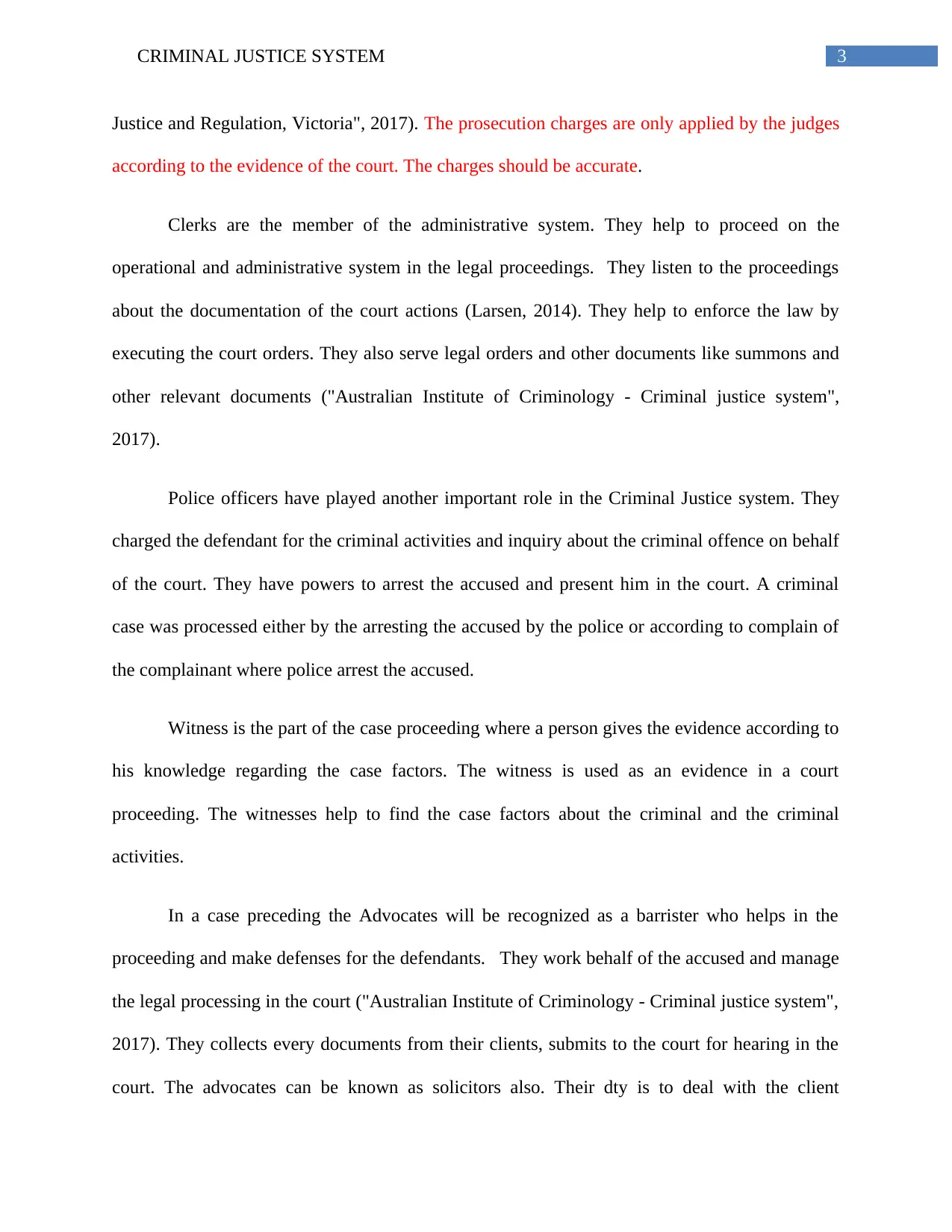
3CRIMINAL JUSTICE SYSTEM
Justice and Regulation, Victoria", 2017). The prosecution charges are only applied by the judges
according to the evidence of the court. The charges should be accurate.
Clerks are the member of the administrative system. They help to proceed on the
operational and administrative system in the legal proceedings. They listen to the proceedings
about the documentation of the court actions (Larsen, 2014). They help to enforce the law by
executing the court orders. They also serve legal orders and other documents like summons and
other relevant documents ("Australian Institute of Criminology - Criminal justice system",
2017).
Police officers have played another important role in the Criminal Justice system. They
charged the defendant for the criminal activities and inquiry about the criminal offence on behalf
of the court. They have powers to arrest the accused and present him in the court. A criminal
case was processed either by the arresting the accused by the police or according to complain of
the complainant where police arrest the accused.
Witness is the part of the case proceeding where a person gives the evidence according to
his knowledge regarding the case factors. The witness is used as an evidence in a court
proceeding. The witnesses help to find the case factors about the criminal and the criminal
activities.
In a case preceding the Advocates will be recognized as a barrister who helps in the
proceeding and make defenses for the defendants. They work behalf of the accused and manage
the legal processing in the court ("Australian Institute of Criminology - Criminal justice system",
2017). They collects every documents from their clients, submits to the court for hearing in the
court. The advocates can be known as solicitors also. Their dty is to deal with the client
Justice and Regulation, Victoria", 2017). The prosecution charges are only applied by the judges
according to the evidence of the court. The charges should be accurate.
Clerks are the member of the administrative system. They help to proceed on the
operational and administrative system in the legal proceedings. They listen to the proceedings
about the documentation of the court actions (Larsen, 2014). They help to enforce the law by
executing the court orders. They also serve legal orders and other documents like summons and
other relevant documents ("Australian Institute of Criminology - Criminal justice system",
2017).
Police officers have played another important role in the Criminal Justice system. They
charged the defendant for the criminal activities and inquiry about the criminal offence on behalf
of the court. They have powers to arrest the accused and present him in the court. A criminal
case was processed either by the arresting the accused by the police or according to complain of
the complainant where police arrest the accused.
Witness is the part of the case proceeding where a person gives the evidence according to
his knowledge regarding the case factors. The witness is used as an evidence in a court
proceeding. The witnesses help to find the case factors about the criminal and the criminal
activities.
In a case preceding the Advocates will be recognized as a barrister who helps in the
proceeding and make defenses for the defendants. They work behalf of the accused and manage
the legal processing in the court ("Australian Institute of Criminology - Criminal justice system",
2017). They collects every documents from their clients, submits to the court for hearing in the
court. The advocates can be known as solicitors also. Their dty is to deal with the client
Paraphrase This Document
Need a fresh take? Get an instant paraphrase of this document with our AI Paraphraser
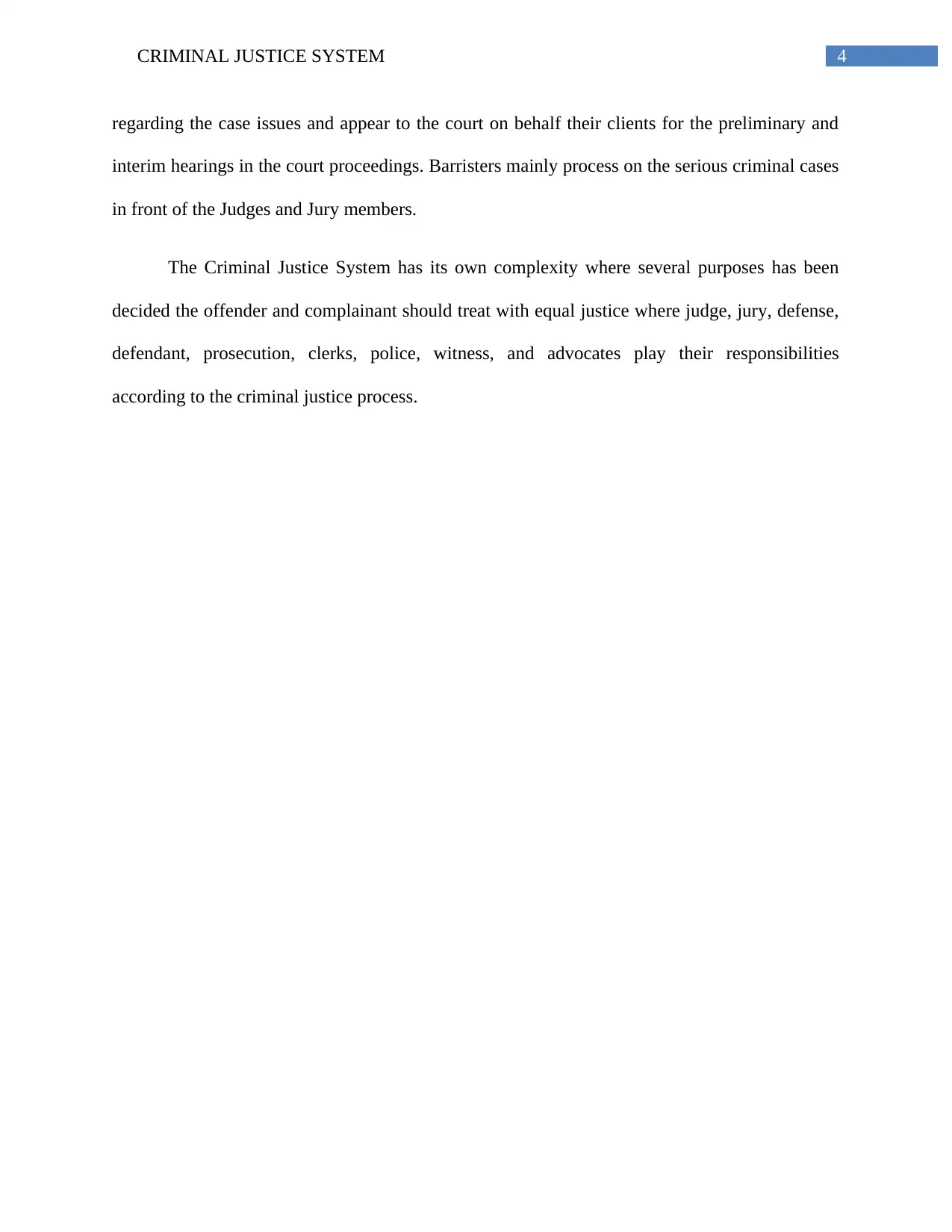
4CRIMINAL JUSTICE SYSTEM
regarding the case issues and appear to the court on behalf their clients for the preliminary and
interim hearings in the court proceedings. Barristers mainly process on the serious criminal cases
in front of the Judges and Jury members.
The Criminal Justice System has its own complexity where several purposes has been
decided the offender and complainant should treat with equal justice where judge, jury, defense,
defendant, prosecution, clerks, police, witness, and advocates play their responsibilities
according to the criminal justice process.
regarding the case issues and appear to the court on behalf their clients for the preliminary and
interim hearings in the court proceedings. Barristers mainly process on the serious criminal cases
in front of the Judges and Jury members.
The Criminal Justice System has its own complexity where several purposes has been
decided the offender and complainant should treat with equal justice where judge, jury, defense,
defendant, prosecution, clerks, police, witness, and advocates play their responsibilities
according to the criminal justice process.
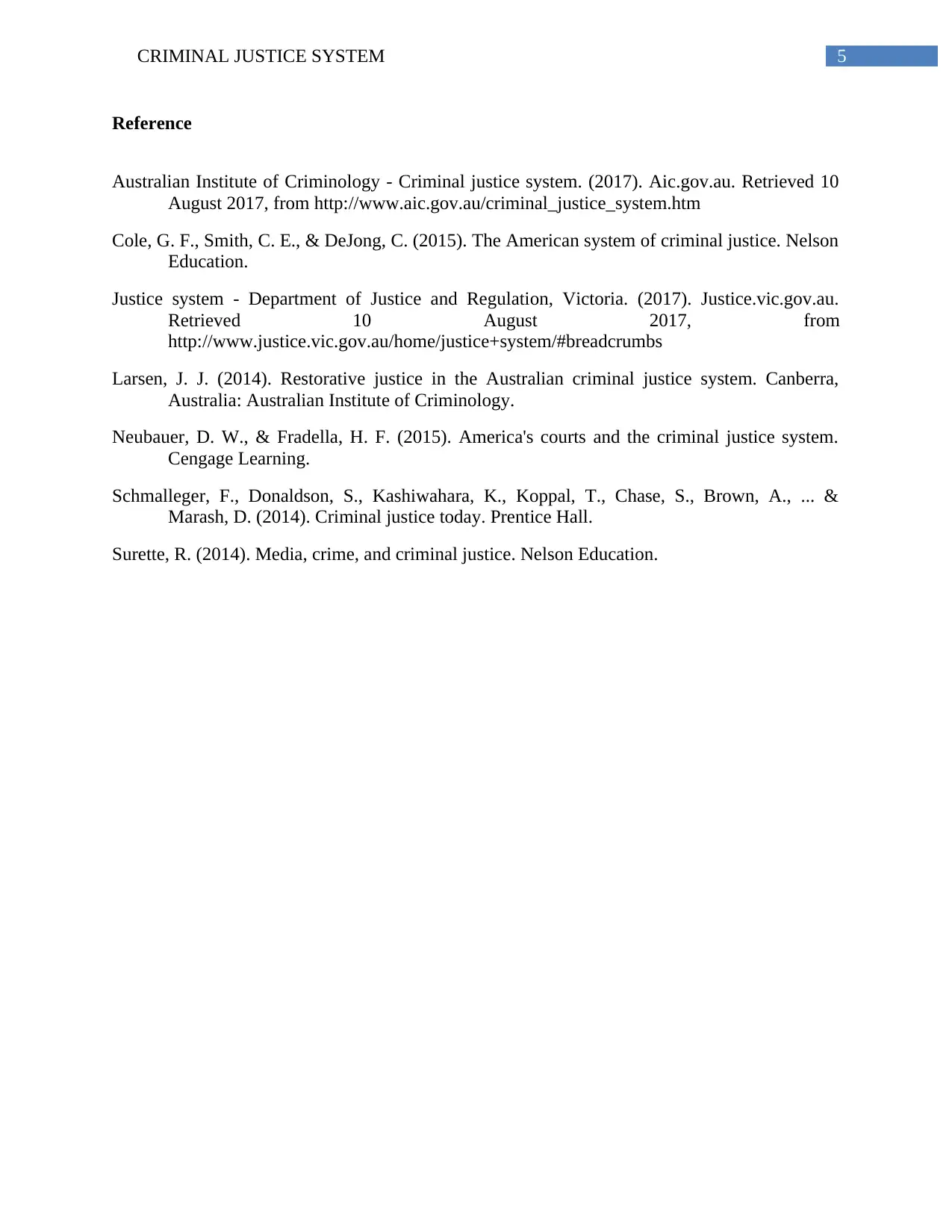
5CRIMINAL JUSTICE SYSTEM
Reference
Australian Institute of Criminology - Criminal justice system. (2017). Aic.gov.au. Retrieved 10
August 2017, from http://www.aic.gov.au/criminal_justice_system.htm
Cole, G. F., Smith, C. E., & DeJong, C. (2015). The American system of criminal justice. Nelson
Education.
Justice system - Department of Justice and Regulation, Victoria. (2017). Justice.vic.gov.au.
Retrieved 10 August 2017, from
http://www.justice.vic.gov.au/home/justice+system/#breadcrumbs
Larsen, J. J. (2014). Restorative justice in the Australian criminal justice system. Canberra,
Australia: Australian Institute of Criminology.
Neubauer, D. W., & Fradella, H. F. (2015). America's courts and the criminal justice system.
Cengage Learning.
Schmalleger, F., Donaldson, S., Kashiwahara, K., Koppal, T., Chase, S., Brown, A., ... &
Marash, D. (2014). Criminal justice today. Prentice Hall.
Surette, R. (2014). Media, crime, and criminal justice. Nelson Education.
Reference
Australian Institute of Criminology - Criminal justice system. (2017). Aic.gov.au. Retrieved 10
August 2017, from http://www.aic.gov.au/criminal_justice_system.htm
Cole, G. F., Smith, C. E., & DeJong, C. (2015). The American system of criminal justice. Nelson
Education.
Justice system - Department of Justice and Regulation, Victoria. (2017). Justice.vic.gov.au.
Retrieved 10 August 2017, from
http://www.justice.vic.gov.au/home/justice+system/#breadcrumbs
Larsen, J. J. (2014). Restorative justice in the Australian criminal justice system. Canberra,
Australia: Australian Institute of Criminology.
Neubauer, D. W., & Fradella, H. F. (2015). America's courts and the criminal justice system.
Cengage Learning.
Schmalleger, F., Donaldson, S., Kashiwahara, K., Koppal, T., Chase, S., Brown, A., ... &
Marash, D. (2014). Criminal justice today. Prentice Hall.
Surette, R. (2014). Media, crime, and criminal justice. Nelson Education.
⊘ This is a preview!⊘
Do you want full access?
Subscribe today to unlock all pages.

Trusted by 1+ million students worldwide
1 out of 6
Related Documents
Your All-in-One AI-Powered Toolkit for Academic Success.
+13062052269
info@desklib.com
Available 24*7 on WhatsApp / Email
![[object Object]](/_next/static/media/star-bottom.7253800d.svg)
Unlock your academic potential
Copyright © 2020–2025 A2Z Services. All Rights Reserved. Developed and managed by ZUCOL.





